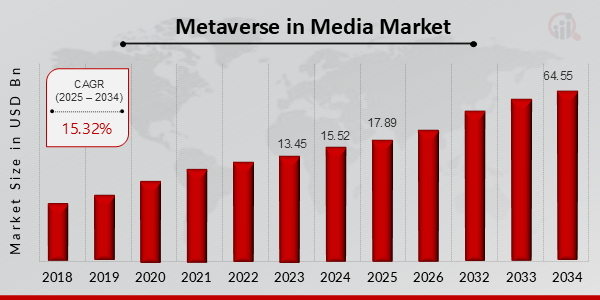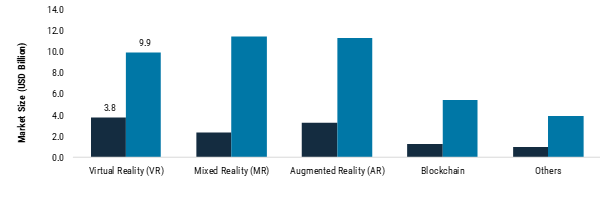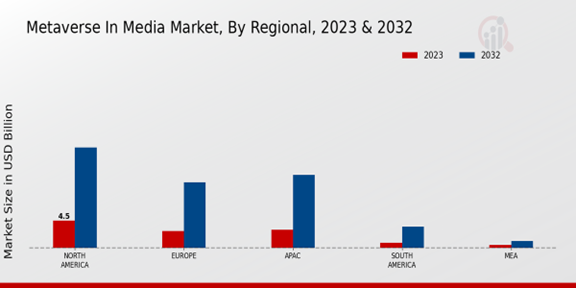Metaverse in Media Market Overview
Metaverse in Media Market is projected to grow from USD 17.89 Billion in 2025 to USD 64.55 Billion by 2034, exhibiting a compound annual growth rate (CAGR) of 15.32% during the forecast period (2025 - 2034). Additionally, the market size for Metaverse in Media Market was valued at USD 15.52 billion in 2024.
Key Metaverse in Media Market Trends Highlighted
The Metaverse in Media Market is experiencing significant growth driven by several key market drivers. One of the primary influences is the increasing demand for immersive experiences in digital content consumption. Consumers are seeking interactive and engaging ways to experience media, which has led to an investment in advanced technologies such as virtual and augmented reality. Additionally, the rise of gaming as a dominant form of entertainment is pushing the boundaries of storytelling and media consumption. Brands and creators are exploring the Metaverse to offer unique advertising opportunities and brand experiences, attracting a broader audience and enhancing customer engagement.
Opportunities to be explored in the Metaverse are vast. Media companies are beginning to understand the potential of blending virtual environments with storytelling, creating spaces where users can interact with content like never before. Live events, concerts, and movie premieres are taking on new forms in the Metaverse, offering fans exclusive access and experiences that were previously unattainable. Moreover, as businesses look to capitalize on the evolving landscape, collaborations between technology firms and content creators can foster innovation, paving the way for new revenue models.
Trends in recent times indicate a clear shift toward user-generated content within Metaverse platforms, empowering creators and encouraging community participation.Social interaction in virtual spaces is becoming a critical aspect of media consumption, with users sharing experiences and forming connections in previously unimagined ways. Gamification is also influencing traditional media practices, as elements typical to gaming, such as rewards and challenges, are being integrated into other media formats. The convergence of these trends highlights a transformative period for the media industry, further solidifying the Metaverse’s place as a vital area for future development and investment.
Figure1: Metaverse in Media Market Overview, 2025 - 2034 (USD Billion)

Source: Primary Research, Secondary Research, Market Research Future Database and Analyst Review
Metaverse in Media Market Drivers
Growing Demand for Immersive Experiences
The growing demand for immersive experiences is a pivotal driver in the Metaverse in Media Market Industry. As technology continues to advance at a rapid pace, consumers increasingly seek out innovative ways to engage with media. This encompasses not just traditional media consumption but also interactive formats that allow users to be active participants in virtual environments.
The advent of technologies such as virtual reality (VR), augmented reality (AR), and mixed reality (MR) has made it possible for media entities to create captivating experiences that transport audiences into the narrative.As consumers crave more personalized and engaging content, companies in the Metaverse in Media Market Industry are investing heavily in developing advanced technologies that facilitate rich multimedia experiences. These developments cater to a vast array of sectors including gaming, entertainment, advertising, and education, all of which are beginning to see the potential of the metaverse as a medium for interaction.
With projections indicating significant market growth in the coming years, the drive for immersive experiences remains at the forefront, as various media firms are eager to integrate new technologies to enhance user engagement.This trend is further exacerbated by the growing prevalence of high-speed internet, making it easier for consumers to access and utilize these immersive platforms without limitations. In turn, this surge in demand contributes to the broader evolution of how media is consumed and experienced, solidifying the metaverse's role as a central player in the future of digital media.
Rise of Social Connectivity
Social connectivity is a major driving factor influencing the Metaverse in Media Market Industry. The shift towards more social and connected digital experiences has led to an increased interest in platforms that support social interaction within virtual environments. As audiences grow increasingly interconnected via social media and online networks, there is a substantial demand for media that encourages social participation and shared experiences. This trend has precipitated the emergence of revolutionary media experiences designed specifically for social engagement, which are integral in attracting users and fostering community.
Furthermore, the growing popularity of influencer marketing, along with rapid breakthroughs in AI and metaverse technology, is supporting the rise of a new social media superstar: virtual influencers. These artificially created personas behave somewhat similarly to actual human influencers. Two major developments that are rapidly dominating the marketing sector are influencer marketing and artificial intelligence. For instance, in a Q3 2023 Sprout Pulse Survey of 307 US-based social marketers, 81% indicated influencer marketing is a critical aspect of their entire social media strategy. Additionally, according to the Sprout Social Index, 81% of marketers believe AI has improved their work.
Metaverse in Media Market Restraint
High Costs Associated with Infrastructure Investments
The metaverse has seen numerous firsts for the media and entertainment (M&E) sector. Businesses use the standard suspects—blockchain, non-fungible tokens (NFTs), augmented reality (AR), artificial intelligence (AI), and virtual reality (VR)—to create immersive experiences. Nevertheless, 5G, data centers, and edge computing cannot yet provide near-zero latency, which is necessary for a fully developed metaverse. Enterprises can give specific metaverse experiences when latency is low enough. User experience suffers when infrastructure performance is subpar. For M&E firms, poor performance makes it hard to monetize digital assets, save expenses, and keep consumers.
Infrastructure planning is important because of the significant investments being made in the metaverse. The infrastructure has to have specific data-handling and transit capabilities in order to achieve near-zero latency.
Increased investment in technology infrastructure is another vital driver behind the growth of the Metaverse in Media Market Industry. As businesses recognize the enormous potential of the metaverse, substantial resources are being funneled into developing the necessary technological foundations like high-speed connectivity, cloud computing, and advanced hardware. This investment not only enhances the quality of virtual experiences but also expands the capabilities of creators and developers who aim to innovate within the media landscape.
Metaverse in Media Market Segment Insights
Metaverse in Media Market Technology Insights
The Metaverse in Media Market encompasses a diverse array of technology-driven segments, with a projected total valuation of 11.66 billion USD in 2023. Within the Technology segment, components such as Virtual Reality and Augmented Reality are foundational, facilitating immersive experiences that enhance user engagement in media. Mixed Reality continues to gain traction, blending physical and digital worlds for richer storytelling. Blockchain technology is crucial for ensuring security and transparency, particularly in digital asset ownership and transactions.The Metaverse in Media Market statistics reflect a trend towards these technologies, underscoring their importance in shaping the future of media consumption and interaction.
Overall, as the market evolves, these technologies stand out for their potential to redefine how content is created, shared, and experienced in the metaverse landscape.
Figure2: Metaverse in Media Market, By Technology, 2023 & 2032 (USD billion)

Source: Primary Research, Secondary Research, Market Research Future Database and Analyst Review
Metaverse in Media Market End Use Insights
The Metaverse in Media Market, valued at approximately 11.66 USD Billion in 2023, is experiencing substantial growth, particularly across its End Use segment. The market is seeing a notable shift as industries leverage immersive technologies to enhance user experiences. The end use segment is bifurcated into OTT platforms, music labels, artists, film production companies, journalism companies and others. The epidemic had a serious toll on the entertainment sector, with musicians and event planners suffering as performances were postponed throughout the globe.
But it also acted as a catalyst for the development of novel event formats, such as large-scale interactive live music concerts. The first sign of the direction the internet is heading and the prospects that come with the upcoming World Wide Web version is the increase of huge interactive live events, or MILEs. When compared to live performances, these MILEs have a number of advantages. They are simple to take care of, to start. Since they are not required to travel anyplace, children do not need to seek their parents for permission before doing so.
From the comfort of their own home, they may attend. Second, individuals have the option to use their avatar as an extension of their real-life persona, allowing them to fully express themselves by showing up to the performance dressed as their favorite character or outfit.For instance, in October 2021 and again in 2022, Decentraland arranged a four-day metaverse festival with eighty different musicians, rather than simply one show. A decentralized autonomous organization (DAO) governs Decentraland, a completely decentralized 3D virtual environment where users may create custom digital experiences and communicate with one another.
Metaverse in Media Market Regional Insights
The Metaverse in Media Market is experiencing substantial growth across various regions, with North America leading the way, valued at 4.5 USD Billion in 2023 and expected to reach 16.5 USD Billion by 2032. This dominance can be attributed to robust technological advancements and a strong entertainment culture. Europe follows with a market valuation of 2.8 USD Billion in 2023, set to grow to 10.8 USD Billion, driven by increasing investments in digital media.
The APAC region, valued at 3.0 USD Billion in 2023 and projected at 12.0 USD Billion, is witnessing a surge due to its young population and rapid digital adoption. South America, with a value of 0.9 USD Billion in 2023, and MEA at 0.5 USD Billion, represent smaller but growing markets, reflecting increasing interest in immersive media experiences. This regional breakdown illustrates the overall segmentation of the Metaverse in Media Market, revealing significant growth opportunities and emphasizing the need for tailored strategies to cater to each market's unique characteristics.
The majority holding by North America highlights its position as a leading player, while the emerging dynamics in APAC showcase potential for rapid expansion.
Figure3: Metaverse in Media Market, By Regional, 2023 & 2032 (USD billion)

Source: Primary Research, Secondary Research, Market Research Future Database and Analyst Review
Metaverse in Media Market Key Players and Competitive Insights
The Metaverse in Media Market has become a dynamic and rapidly evolving space characterized by innovative technologies and a surge in user engagement across digital platforms. As traditional media converges with virtual environments, a multitude of players is entering the arena, each bringing unique strengths and capabilities to capitalize on the unprecedented opportunities presented by this immersive digital landscape. Competitive insights within this market highlight the importance of strategic partnerships, technological advancements, and content creation as key drivers influencing market positioning.
Companies are focusing on enhancing user experiences through increasingly sophisticated virtual interactions, which include augmented reality and virtual reality applications, thus reshaping how media content is consumed and monetized.Tencent stands out prominently in the Metaverse in Media Market due to its vast ecosystem that seamlessly integrates social media, gaming, and digital content. With a robust market presence, Tencent leverages its significant user base to foster community engagement and interactive experiences that are crucial in a metaverse context. The company’s strengths lie in its extensive investments in gaming platforms, creating a fertile ground for immersive media experiences.
Additionally, Tencent’s ability to develop and distribute a rich array of multimedia content, combined with its technological prowess in cloud computing and AI, positions it advantageously to harness the potential of the metaverse. The company's strategic collaborations with various entities further enhance its capabilities in providing compelling and diversified content, making it a formidable player in the evolving metaverse landscape.Sandbox is another key player within the Metaverse in Media Market, carving out a niche focused on user-generated content and gaming experiences.
The company has developed a decentralized platform allowing users to create, own, and monetize their gaming experiences while interacting in a vibrant virtual world. Sandbox's strengths include a robust framework for facilitating creativity and collaboration, empowering users to engage directly with their digital assets while participating in a vibrant community. The platform endeavors to consolidate real ownership of digital creations through blockchain technology, significantly influencing how media is produced and consumed in the metaverse environment. By fostering a community-driven atmosphere and emphasizing creative freedom, Sandbox exemplifies a unique approach that could reshape content dynamics within the burgeoning metaverse media landscape.
Their focus on providing tools and features that let users express their creativity further contributes to the ongoing growth and popularity of their platform.
Key Companies in the Metaverse in Media Market Include
Metaverse in Media Market Industry Developments
Tencent has been enhancing its footprint in the global metaverse, looking at new partnerships within the gaming and social media sectors to strengthen its ecosystem. The Sandbox continues to expand its digital real estate offerings, attracting attention from brands seeking to enter the metaverse space. Sony is strategically investing in metaverse-related technologies, aiming to integrate its gaming portfolio further into immersive environments. Meta, previously known as Facebook, has reported a significant investment by acquiring multiple startups focusing on augmented and virtual reality capabilities.
Roblox Corporation has launched initiatives aimed at fostering a new wave of user-generated content, anticipating revenue growth through its innovative platform. Snap Inc. is collaborating with creators to leverage AR tools, enhancing user experiences. Alphabet is reportedly developing new tools to optimize virtual interactions, while Disney is working on integrating its IP into immersive experiences within the metaverse. Recent market trends indicate growth in company valuations, with NVIDIA and Unity Technologies benefiting from the rising demand for metaverse-related graphics and development solutions. Additionally, Microsoft has seen acquisitions that bolster its metaverse ambitions, showcasing a competitive landscape poised for evolution.
Metaverse in Media Market Segmentation Insights
Metaverse in Media Market Technology Outlook
Metaverse in Media Market End Use Outlook
Metaverse in Media Market Regional Outlook
|
Report Attribute/Metric
|
Details
|
|
Market Size 2024
|
15.52 (USD Billion)
|
|
Market Size 2025
|
17.89 (USD Billion)
|
|
Market Size 2034
|
64.55 (USD Billion)
|
|
Compound Annual Growth Rate (CAGR)
|
15.32% (2025 - 2034)
|
|
Report Coverage
|
Revenue Forecast, Competitive Landscape, Growth Factors, and Trends
|
|
Base Year
|
2024
|
|
Market Forecast Period
|
2025 - 2034
|
|
Historical Data
|
2019 - 2023
|
|
Market Forecast Units
|
USD Billion
|
|
Key Companies Profiled
|
Tencent, Sandbox, Meta Platforms Inc., Roblox Corporation, Snap Inc., Alphabet, NVIDIA, Unity Technologies, Amazon, Decentraland, Epic Games, Microsoft
|
|
Segments Covered
|
Technology, End Use, Regional
|
|
Key Market Opportunities
|
Immersive storytelling experiences, Virtual events and concerts, Brand collaborations in virtual worlds, Advertising in immersive environments, Interactive gaming partnerships
|
|
Key Market Dynamics
|
Immersive user experiences, Digital content diversification, Cross-platform interoperability, Virtual advertising opportunities, Enhanced social interaction
|
|
Regions Covered
|
North America, Europe, Asia-Pacific, South America, Middle East & Africa
|
Frequently Asked Questions (FAQ):
The Global Metaverse in Media Market is expected to be valued at 64.55 USD Billion by 2034.
The expected CAGR for the Metaverse in Media Market from 2025 to 2034 is 15.32%.
North America is expected to dominate the Metaverse in Media Market with a value of 16.55 USD Billion by 2034.
Some of the key players in the market include Tencent, Meta Platforms Inc., and Sandbox among others.
The expected value of the Metaverse in Media Market in the APAC region is projected to be 12.0 USD Billion by 2034.

















